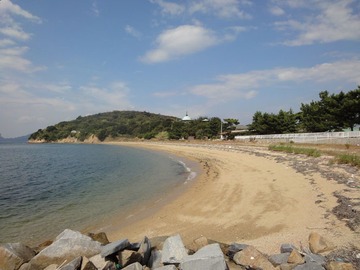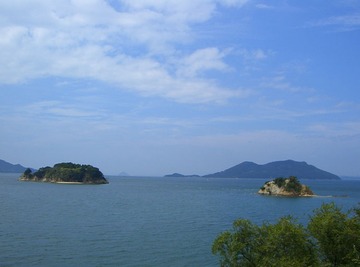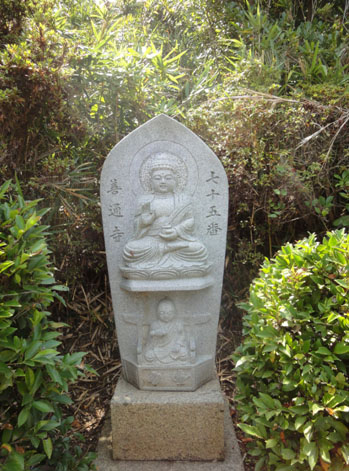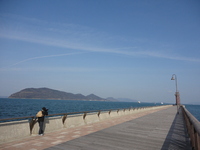2010年11月08日
TheGentleArtProject Revisited2
Setouchi International Art Festival
Oshima Revisited: The Gentle Art Project * Part 2
Highlights
Those of us lucky enough to go to Oshima during the festival were given a 60-minute guided tour and then allowed to wander in designated places that did not intrude on the residents’ privacy if there was any time left over. The guides gave an extremely well informed account of the sanatorium’s history and the people who live here. Because there are few records, these volunteers actually gathered much of the information directly from local residents. This type of interaction with the islanders was a key part of the project. Using art as a medium, the project captured the attention of people who had been unaware of the residents’ plight and helped residents and visitors take a step towards ending social isolation.
Our first stop was a memorial building that houses cinerary urns containing the ashes of the deceased. We said prayers at the altar outside.

Roof of memorial building viewed from the pier.
The day I went, we were extremely fortunate to be invited inside the building, which had been opened for a special group. The interior is lined with glass cases filled with more than 2,000 small cinerary urns carefully wrapped in beautiful brocade. The respect shown in this room seemed to me to reflect the positive change in society’s attitude towards its former outcasts.
The monuments in the photo below told us more of the islanders’ story.

Stone monuments.
If someone had Hansen’s disease and was sent to a sanatorium, the rest of the family hid that fact for fear of social ostracism. The person was considered already dead and therefore no one went to collect his or her ashes when they actually passed away. In the photo above, the monument on the left is dedicated to over 600 early residents and contains the ashes and bones that did not go into the urns. The monument in the middle is dedicated to the souls of the residents’ unborn children. Couples who married were sterilized but sometimes the operation failed, resulting in pregnancy. In that case, the child had to be aborted. The stone on the right is dedicated to the first medical doctor to become sanatorium director. I was surprised to see that he was treated so specially until our guide explained that previous directors had been from the police department. It really brought home the fact that the early sanatoriums were not built to help or cure the residents but to prevent them from escaping back to the “normal” world.

View of Ogijima back right (Photo by Kazumi)
Life was so hard in the early decades that quite a few residents did in fact attempt to escape by swimming across to other islands only to be caught and returned. They would be heading towards islands like Ogijima, the one in the far distance in the above photo. Considering the tides and the distance, it would not be an easy swim so the escapees must have been pretty desperate. Some did not make it while others did not try. They simply committed suicide by jumping in the sea. The bodies washing up on nearby shores probably deepened the fear and prejudice of local people who lived near Oshima. Living conditions on the island, particularly in the early years, were harsh, with 12 people living in 24-mat rooms (about 3 square meters/person), each with only a tiny wooden cupboard to store their few belongings. Obviously, there was no privacy. Inmates included children with leprosy or children exiled with parents who had leprosy. Some of the sanatorium employees also had children so that at one point there were three schools to segregate the different children and the island was divided into yūdoku (“toxic”) and mudoku (“non-toxic”) zones. Conditions gradually improved and each resident now has a small one-room apartment with a kitchen, a closet and a separate entrance, plus some space outside for gardening.

Resident’s impressive bonsai garden.
The sanatorium tried to be as self-sufficient in food production as possible. The residents thus grew much of their own food and there are still small vegetable plots on the island. From the bonsai collection in the photo above, you can see that some residents really take pride in their gardening skills.

White lines
The disease has impaired the eyesight of many residents. White lines on the road help them find their way and they can also tap their canes along the metal railings that line the roadside. Speakers at every intersection play music to help them keep their bearings.

Speaker and railing
Shikoku has a centuries-old pilgrimage route to 88 temples around the entire island. It takes a few months to complete on foot. These 88 temples each donated a statue to the island so that residents could complete the pilgrimage without leaving Oshima.

Buddhist statue donated by Zentsuji Temple, home of Kobo Daishi, the pilgrimage route foundering
In 1992, a thousand volunteers and residents worked together to create the monument below. Called Kaze no mai or “Wind Dance”, it is located behind the crematorium and contains the leftover ashes and bones of more recent residents. The name represents the islanders’ hope that at least in death they can be set free and return to their homelands.

Wind Dance monument (photos by Kazumi)
Wind Dance was built before the segregation law was repealed and it stands as a testimony to the fact that many people had been advocating the rights of sanatorium residents long before the laws changed. The monument and the art project serve as excellent reminders that changes for the better are brought about by ordinary citizens who care; by people who see beyond such differences as “disability”, “race” or “gender” to the common humanity in the heart of each one of us and are willing to stand up against injustice.

The festival ended on October 31, 2010. I am hoping that the project will continue in some form or other because it provided a great vehicle for Oshima residents and “outsiders” to come together as fellow human beings. The festival’s Japanese website says that it will at least open again for a few days in December but the details are still under discussion. Once decided the details will be posted on the Japanese festival website: http://setouchi-artfest.jp/
Here also is the list of sites that will stay open until Dec. 31:
http://setouchi-artfest.jp/images/uploads/misc/artworks_20101101_20101231r.pdf
It is still possible to visit Oshima regardless of the festival and the boat is free but you need to contact the National Sanatorium Oshima Seishoen to get permission. The phone number is 087-871-3131 (Japanese only). The facility offers a tour of the sanatorium that includes a talk by the facility doctor and time to interact with the residents (again in Japanese). You can arrange to take a group or, if you are going with only a few people, you can arrange to be included in another group’s tour. Call the facility to ask for a suitable date and time and then send a letter addressed to the director stating when you are going. The boat timetable is here:
http://www.hosp.go.jp/~osima/timetable/H221001~H230331.pdf
The Japanese website is here: http://www.hosp.go.jp/~osima/index1.html
I know for many of you this will involve getting a Japanese person to help you but it is worth the effort.
*Again, many thanks to art project director Nobuyuki Takahashi and the Koebitai volunteers for so much helpful information.

View looking out from Oshima.
Oshima Revisited: The Gentle Art Project * Part 2
Highlights
Those of us lucky enough to go to Oshima during the festival were given a 60-minute guided tour and then allowed to wander in designated places that did not intrude on the residents’ privacy if there was any time left over. The guides gave an extremely well informed account of the sanatorium’s history and the people who live here. Because there are few records, these volunteers actually gathered much of the information directly from local residents. This type of interaction with the islanders was a key part of the project. Using art as a medium, the project captured the attention of people who had been unaware of the residents’ plight and helped residents and visitors take a step towards ending social isolation.
Our first stop was a memorial building that houses cinerary urns containing the ashes of the deceased. We said prayers at the altar outside.

Roof of memorial building viewed from the pier.
The day I went, we were extremely fortunate to be invited inside the building, which had been opened for a special group. The interior is lined with glass cases filled with more than 2,000 small cinerary urns carefully wrapped in beautiful brocade. The respect shown in this room seemed to me to reflect the positive change in society’s attitude towards its former outcasts.
The monuments in the photo below told us more of the islanders’ story.

Stone monuments.
If someone had Hansen’s disease and was sent to a sanatorium, the rest of the family hid that fact for fear of social ostracism. The person was considered already dead and therefore no one went to collect his or her ashes when they actually passed away. In the photo above, the monument on the left is dedicated to over 600 early residents and contains the ashes and bones that did not go into the urns. The monument in the middle is dedicated to the souls of the residents’ unborn children. Couples who married were sterilized but sometimes the operation failed, resulting in pregnancy. In that case, the child had to be aborted. The stone on the right is dedicated to the first medical doctor to become sanatorium director. I was surprised to see that he was treated so specially until our guide explained that previous directors had been from the police department. It really brought home the fact that the early sanatoriums were not built to help or cure the residents but to prevent them from escaping back to the “normal” world.

View of Ogijima back right (Photo by Kazumi)
Life was so hard in the early decades that quite a few residents did in fact attempt to escape by swimming across to other islands only to be caught and returned. They would be heading towards islands like Ogijima, the one in the far distance in the above photo. Considering the tides and the distance, it would not be an easy swim so the escapees must have been pretty desperate. Some did not make it while others did not try. They simply committed suicide by jumping in the sea. The bodies washing up on nearby shores probably deepened the fear and prejudice of local people who lived near Oshima. Living conditions on the island, particularly in the early years, were harsh, with 12 people living in 24-mat rooms (about 3 square meters/person), each with only a tiny wooden cupboard to store their few belongings. Obviously, there was no privacy. Inmates included children with leprosy or children exiled with parents who had leprosy. Some of the sanatorium employees also had children so that at one point there were three schools to segregate the different children and the island was divided into yūdoku (“toxic”) and mudoku (“non-toxic”) zones. Conditions gradually improved and each resident now has a small one-room apartment with a kitchen, a closet and a separate entrance, plus some space outside for gardening.

Resident’s impressive bonsai garden.
The sanatorium tried to be as self-sufficient in food production as possible. The residents thus grew much of their own food and there are still small vegetable plots on the island. From the bonsai collection in the photo above, you can see that some residents really take pride in their gardening skills.

White lines
The disease has impaired the eyesight of many residents. White lines on the road help them find their way and they can also tap their canes along the metal railings that line the roadside. Speakers at every intersection play music to help them keep their bearings.

Speaker and railing
Shikoku has a centuries-old pilgrimage route to 88 temples around the entire island. It takes a few months to complete on foot. These 88 temples each donated a statue to the island so that residents could complete the pilgrimage without leaving Oshima.

Buddhist statue donated by Zentsuji Temple, home of Kobo Daishi, the pilgrimage route foundering
In 1992, a thousand volunteers and residents worked together to create the monument below. Called Kaze no mai or “Wind Dance”, it is located behind the crematorium and contains the leftover ashes and bones of more recent residents. The name represents the islanders’ hope that at least in death they can be set free and return to their homelands.

Wind Dance monument (photos by Kazumi)
Wind Dance was built before the segregation law was repealed and it stands as a testimony to the fact that many people had been advocating the rights of sanatorium residents long before the laws changed. The monument and the art project serve as excellent reminders that changes for the better are brought about by ordinary citizens who care; by people who see beyond such differences as “disability”, “race” or “gender” to the common humanity in the heart of each one of us and are willing to stand up against injustice.

The festival ended on October 31, 2010. I am hoping that the project will continue in some form or other because it provided a great vehicle for Oshima residents and “outsiders” to come together as fellow human beings. The festival’s Japanese website says that it will at least open again for a few days in December but the details are still under discussion. Once decided the details will be posted on the Japanese festival website: http://setouchi-artfest.jp/
Here also is the list of sites that will stay open until Dec. 31:
http://setouchi-artfest.jp/images/uploads/misc/artworks_20101101_20101231r.pdf
It is still possible to visit Oshima regardless of the festival and the boat is free but you need to contact the National Sanatorium Oshima Seishoen to get permission. The phone number is 087-871-3131 (Japanese only). The facility offers a tour of the sanatorium that includes a talk by the facility doctor and time to interact with the residents (again in Japanese). You can arrange to take a group or, if you are going with only a few people, you can arrange to be included in another group’s tour. Call the facility to ask for a suitable date and time and then send a letter addressed to the director stating when you are going. The boat timetable is here:
http://www.hosp.go.jp/~osima/timetable/H221001~H230331.pdf
The Japanese website is here: http://www.hosp.go.jp/~osima/index1.html
I know for many of you this will involve getting a Japanese person to help you but it is worth the effort.
*Again, many thanks to art project director Nobuyuki Takahashi and the Koebitai volunteers for so much helpful information.

View looking out from Oshima.
My Profile
Cathy Hirano キャシー ヒラノ
I've lived in Japan since 1978. After graduating from a Japanese university with a BA in cultural anthropology in 1983, I worked as a translator in a Japanese consulting engineering firm in Tokyo for several years. My Japanese husband and I moved to Takamatsu in 1987 to raise our two children in a slower-paced environment away from the big city pressures. We've never regretted it. I work as a freelance translator and interpreter and am involved in a lot of community work, including volunteering for Second Hand, a local NGO that supports educational and vocational training initiatives in Cambodia, and for the Takamatsu International Association. I love living in Takamatsu.
Cathy Hirano キャシー ヒラノ
I've lived in Japan since 1978. After graduating from a Japanese university with a BA in cultural anthropology in 1983, I worked as a translator in a Japanese consulting engineering firm in Tokyo for several years. My Japanese husband and I moved to Takamatsu in 1987 to raise our two children in a slower-paced environment away from the big city pressures. We've never regretted it. I work as a freelance translator and interpreter and am involved in a lot of community work, including volunteering for Second Hand, a local NGO that supports educational and vocational training initiatives in Cambodia, and for the Takamatsu International Association. I love living in Takamatsu.
Posted by cathy at 14:00│Comments(1)
│art
この記事へのコメント
Hi Cathy,
Once again thank you so much for such an informative post about Oshima.
Once again thank you so much for such an informative post about Oshima.
Posted by David at 2010年11月16日 20:48
※会員のみコメントを受け付けております、ログインが必要です。







